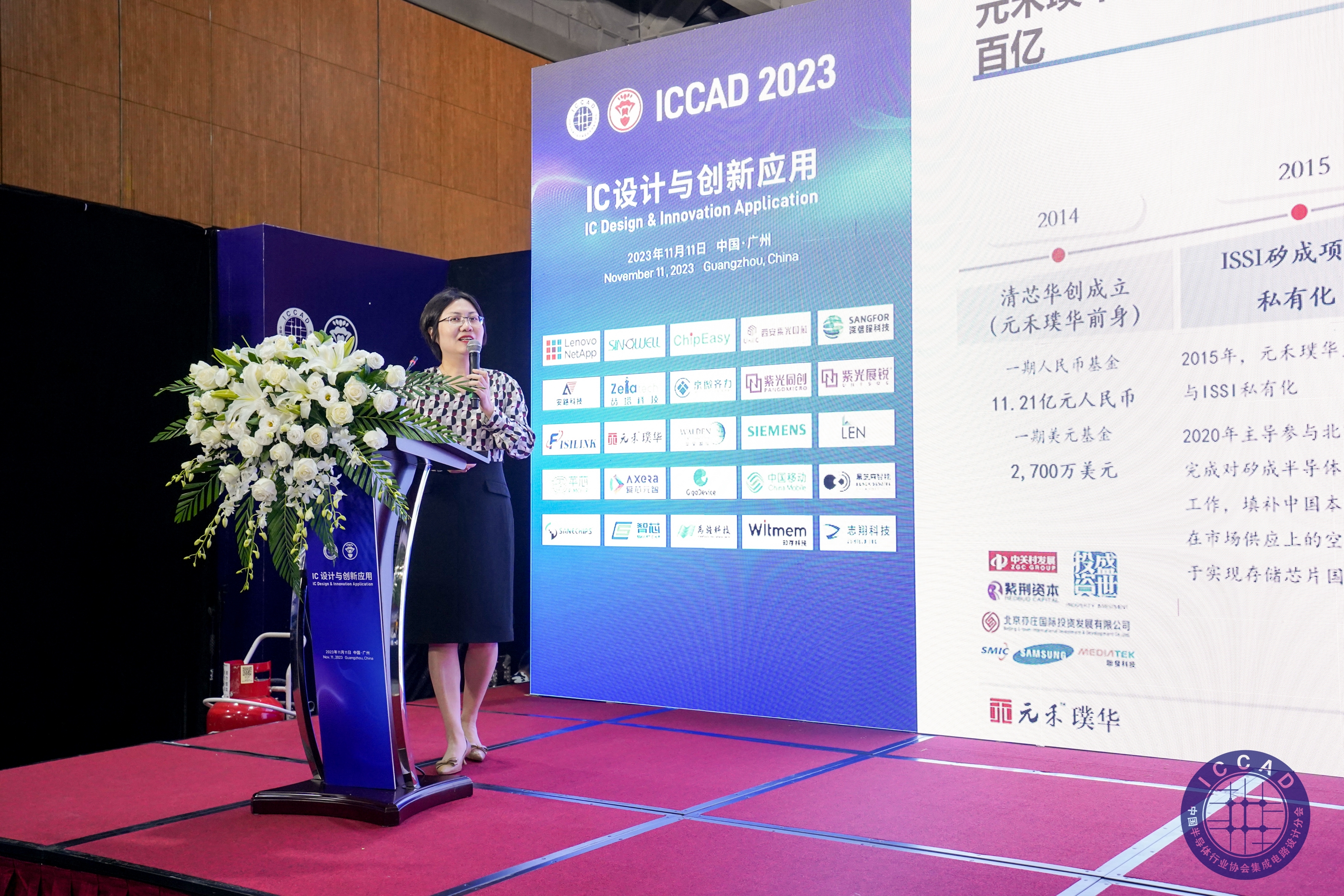
By Kate Yuan
(JW Insights) Nov 16 -- China’s AI chips and equipment contain numerous opportunities in 2024 under the background of supply chain reconstruction in the country. This is a key point by Chen Yu, executive director of China’s leading IC investment institution Hua Capital (元禾璞华) in her presentation to China's IC design community last week.

Chen delivered her presentation at ICCAD 2023 held in Guangzhou from November 10 to 11.
As an investment expert in the integrated circuit industry, Hua Capital has invested widely in automotive, industrial, and consumer devices, equipment, materials and EDA. It played a lead investor role in 60% of involved projects.
Chen Yu said that the semiconductor industry is in a moderate stage of recovery as shown from multidimensional data such as imports and exports. The global semiconductor market is expected to rebound in 2024 in a range of 10% to 18.5%, according to the predictions of major institutions.
China imported 355.9 billion ICs in January-September 2023, down 14.6% over the last year, valued at $252.9 billion. China exported 199.9 billion ICs, down 5.1% year on year, reaching $98.57 billion, showed the data released by the General Administration of Customs of China.
“Although the figures are still declining as of September, the year-on-year decline has significantly reduced in the second half of the year, indicating a trend of moderate recovery, which is a very important signal,” said Chen.
The foundry industry is also experiencing a rebound and upward trend. The performance of 12-inch wafer foundries is better than that of 8-inch, reflecting a stronger demands for high-end products such as AI chips. In comparison, the traditional consumer electronics market has shown no significant increase.
But the US export controls introduced last year and this year remain factors affecting the global supply chain and China’s production of advanced chips. Those regulations focus on restricting semiconductor manufacturing capabilities through controls on semiconductor equipment and other related aspects.
"After nearly two-year-long market downturn, there have been bright spots in device innovation, specifically the extension of generative AI from the cloud to the edge. The combination of AI technology with PCs and smartphones has become a trend, such as Qualcomm's launch of the Snapdragon X Elite platform for PCs," said Chen.
2024 will be the inaugural year for AI-powered PCs, and it is worth paying attention to the shipments of Lenovo, Samsung, Asus, Dell, HP, Honor, and others, according to Chen.
“Smartphone makers are making significant efforts to extend AI to the edge. The system-on-a-chip (SoC) processors, including those from MediaTek and Qualcomm, will integrate more powerful AI engines to support AI applications on devices, which has become a trend. The innovation of AI in devices has gradually influenced chip design, and upstream companies may benefit from the new demand in the next few years,” said Chen.
In semiconductor equipment sector, support has been built up for nodes above 28 nanometers, and the proportion of localization has increased.
Data shows that China’s mainland became the world's largest semiconductor equipment market for the third consecutive year in 2022, with a scale of $28.3 billion, accounting for 26.3% and reaching a historical high. In the field of front-end wafer manufacturing equipment, the market size of thin film deposition equipment, lithography machines, etching equipment, metrology/detection equipment, and cleaning equipment ranks in the top five.
“The localization rate of thin film deposition equipment, etching equipment, and cleaning equipment exceeds 25%, while that of lithography machines and metrology/detection equipment is relatively low. In addition, that of CMP equipment and thermal processing equipment is good, while that of resist coater and developer equipment, which is compatible with lithography machines, is relatively low,” said Chen.
As for the sub-segments related to equipment, the localization of components and consumables is also a focus. Chen said that currently, quartz has the highest localization rate, followed by silicon components, with ceramics slightly lagging behind. “We plan to explore and support manufacturers in this area. In addition, we are highly interested in areas such as vacuum gauges, RF power supplies, and flow meters," Chen added.
In terms of semiconductor materials, the localization of seven major categories of materials is receiving significant attention, including photomasks, silicon wafers, photoresists, wet chemicals, sputtering targets, electronic specialty gases, CMP polishing fluids, and polishing pads.
Chen said that the localization of silicon wafers is no longer an issue and is currently in a state of oversupply. Upstream materials for photomasks still pose a bottleneck, while there have been significant achievements in the localization of electronic specialty gases and other categories of materials.
"Overall, Hua Capital will support companies that achieve independent innovation in underlying core technologies such as high-computing chips, equipment, components and materials. We will also explore investment opportunities in semiconductor design and equipment, focusing on deepwater areas and specialized opportunities. We will also further explore and accelerate the process of domestic substitution in the component and material fields," Chen added.
For the new opportunities for Hua Capital, Chen pointed to innovation in end applications, and the arrival of the era of mergers and acquisitions through early-stage and small-scale innovative investments.
RELATED
-
Chinese leading Wi-Fi FEM provider Kxcomtech debuts on Shanghai Stock Exchange STAR Market with a 178.67% surge on the first day
11-17 14:13 -
Chinese GPU startup Moore Threads completes B+ round of funding
11-16 15:17 -
China kicks off construction of world’s largest offshore PV power station
11-14 17:21
READ MOST

No Data Yet~







